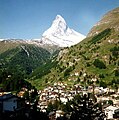Matterhorn
- For the Italian town named Cervino, see Cervino (CE).
| Matterhorn |
|---|
The Matterhorn (Italian: Monte Cervino, French: Mont Cervin or Le Cervin) is perhaps the most familiar mountain in the European Alps. On the border between Switzerland and Italy, its graceful pyramid towers over the Swiss town of Zermatt and the Italian town Breuil-Cervinia in the Val Tournanche.
Description
The Matterhorn has four faces, facing the four compass points, with the north and south faces meeting to form a short east-west summit ridge. The faces are steep, and only small patches of snow and ice cling to them; regular avalanches send the snow down to accumulate on the glaciers at the base of each face. The Hörnli ridge of the northeast (in the center of the view from Zermatt) is the usual climbing route. The North face is one of the six great north faces of the Alps, first climbed in 1931 by brothers Franz and Toni Schmid.
The Matterhorn was the last major mountain of the Alps to be climbed, not because of its technical difficulty, but because of the fear it inspired in early mountaineers. The first serious attempts began around 1858, mostly from the Italian side, but despite appearances, the southern routes are harder, and parties repeatedly found themselves on difficult slippery rock and had to turn back.

It was not until 14 July 1865, after several failed attempts and some nationalistically motivated backstabbing, that the party of Edward Whymper, Charles Hudson, Lord Francis Douglas, and Douglas Hadow, with Michel Croz and the two Peter Taugwalders (father and son) tried the Hörnli route and found it considerably easier than expected. On the descent Hadow slipped, knocking Croz off his feet, and dragging Hudson and Douglas with him. The rope connecting them to the other three men broke; the four fell to their deaths on the Matterhorn Glacier 1,400 m below. The bodies of all but Douglas were later found, and are buried in the Zermatt churchyard.
Three days later, on 17 July, a party led by Jean-Antoine Carrel reached the summit from the Italian side. Julius Elliott made the second ascent from the Zermatt side, in 1868, and soon after John Tyndall traversed the summit. In 1871, Lucy Walker became the first woman to stand on top of the mountain, followed a few weeks later by her rival Meta Brevoort.
Today, all ridges and faces of the Matterhorn have been ascended in all seasons, and climbing guides take thousands up the Hörnli route each summer. By modern standards, the climb is technical (AD Difficulty rating) but not difficult for skilled mountaineers. There are fixed ropes on parts of the route to help. Still, due to inexperience, falling rocks, and overcrowded routes, several climbers die each year . The mountain is not to be underestimated. The usual pattern is to take the Schwarzee cable car up from Zermatt, hike up to the Hörnli-hütte (elev. 3,260 m), a large stone building at the base of the main ridge, and spend the night. The next day the climber rises at 4:00 am, so as to reach the summit and descend before the regular afternoon clouds and storms come in.
Other 'Matterhorns'
Many other prominent mountains around the world are nicknamed the 'Matterhorn' of their respective countries or mountain ranges. Examples include Cnicht ('the Matterhorn of Wales'), Mount Assiniboine ('the Matterhorn of the Rockies'), Innerdalstårnet ('Norway's Matterhorn'), Machhapuchhare ('the Matterhorn of Nepal'), Shivling ('the Matterhorn of India') and Ama Dablam ('the Matterhorn of the Himalaya'). Of these, Cnicht is possibly the least convincing.
An even more phantasmal version is Parascotopetl, the 'Matterhorn of the Andes', which - unlike all of the above-listed peaks except Machhapuchhare - has yet to have had a real ascent, as it appears only in the pages of H. G. Wells's short story, 'The Country of the Blind' (1904).
A miniature imitation of the Matterhorn featuring a bobsled ride is one of the attractions at Disneyland in Anaheim, California. Matterhorn Bobsleds opened in 1959 and is a 1/100 scale replica (147 feet in height) of the actual mountain in the Swiss Alps, although not exact. The attraction was one of the first E ticket rides in Disneyland Park, with the Submarine Voyage being the first in the same summer.
A mountain called the "Murderhorn" features in an episode of The Simpsons, King of the Hill.
Prominence
Despite its prominence in a general sense, the Matterhorn is not among the top 100 mountains in the Alps measured by topographic prominence. This is because several of its close neighbors, including Monte Rosa, the Dom, Liskamm and the Weisshorn, have higher summits.

See also
- The Haute Route from Chamonix to Zermatt
- Toblerone
References
- Charles Gos, Le Cervin (Attinger, 1948)
- Edward Whymper, Scrambles Amongst the Alps (1871)
External links
- Matterhorn Webcams
- Matterhorn on Summitpost
- PeakWare info on Matterhorn
- Matterhorn on 4000er.de
- Pictures from a climb
- Hörnli-hütte page
- Walt Disney and Zermatt
- Disneyland in 1959
- Chronology of climbs - in German
- Photo Matterhorn from Zermatt
Gallery
-
East and north face
-
The Matterhorn reflected in The Riffelsee
-
The east and north faces viewed from Zermatt
-
South face viewed from Skigebiet Breuil-Cervinia
-
East and north face viewed from Rothorn
-
The Matterhorn and the Swiss town of Zermatt
-
Matterhorn Flyby (1/8)
-
Matterhorn Flyby (2/8)
-
Matterhorn Flyby (3/8)
-
Matterhorn Flyby (4/8)
-
Matterhorn Flyby (5/8)
-
Matterhorn Flyby (6/8)
-
Matterhorn Flyby (7/8)
-
Matterhorn Flyby (8/8)





